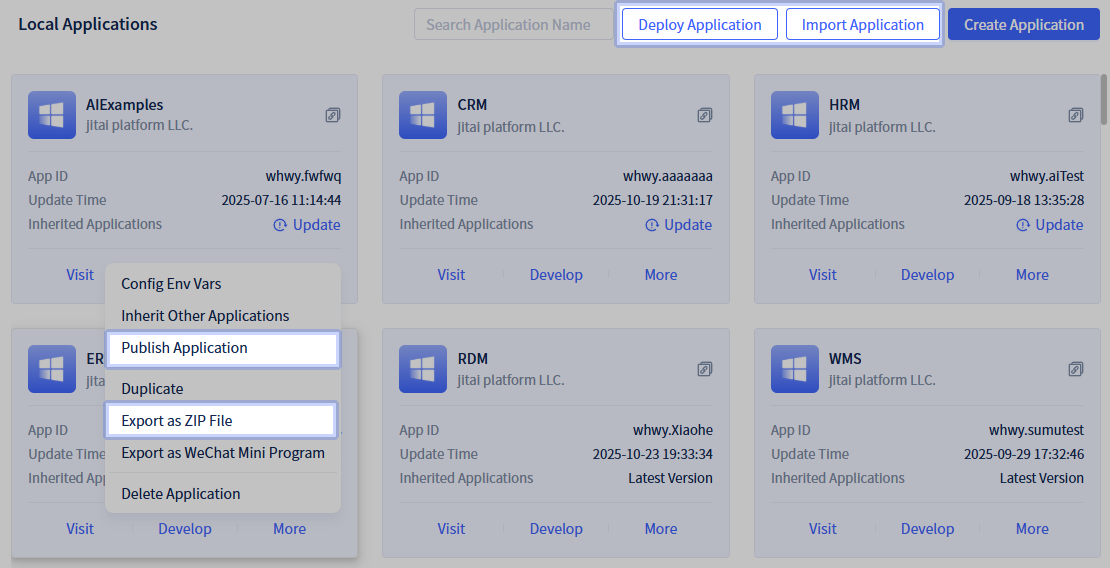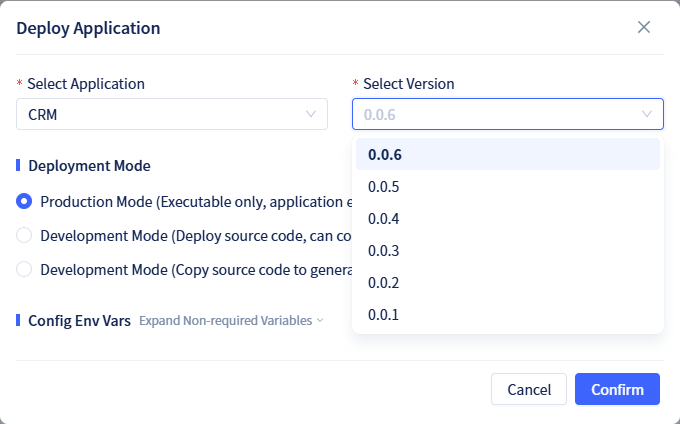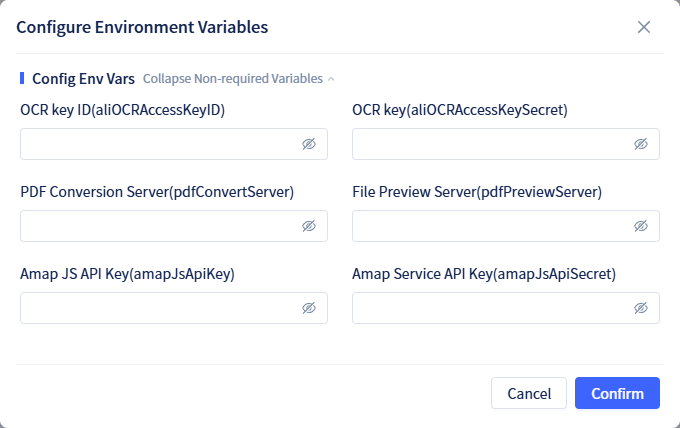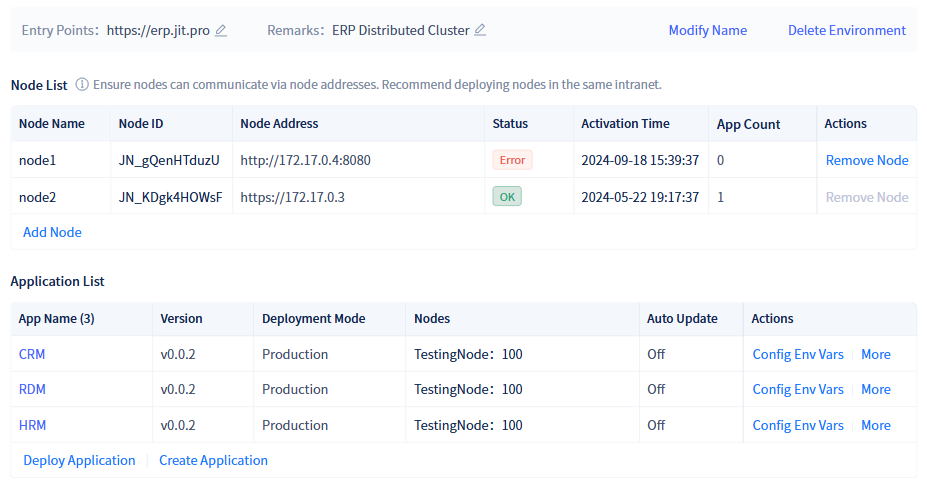Quickly Build Production-Grade AI Apps
Production-Grade AI Application Development
A full-stack development framework for LLMs, AI workflows, AI agents, and AI-assisted human–UI collaboration — radically simplifying the rapid development of production-grade AI applications.
A comprehensive integration of modern information technologies that streamlines the rapid development of AI-native, enterprise-grade IT applications.
Interpretable AI-Native Application Architecture
World's first system-level full-stack AI context, enabling AI intelligence to perceive and drive everything, allowing enterprise systems to fully embrace AI and unleash the long-term value of AI intelligence.
Interpretable JAAP protocol and application inheritance mechanism enable infinite and arbitrary expansion of the entire system while maintaining simplicity and elegance.
Orchestration-Based Development Paradigm
Visual orchestration-based development tools, increasing development efficiency by 10 times and reducing development barriers by 90%.
Orchestration-based extensible rectangular development framework, making applications extremely streamlined and reducing application complexity by 100 times.
Evergreen Privatization
Platform ready-to-use, one-click application deployment, all automatically updated, zero-cost deployment and update.
Visual orchestration of distributed clusters.
Seamless Integration and Infinite Extension
Can infinitely integrate any technology into orchestration mod.
Can infinitely extend and modify any integration.
Jit Runtime Platform
On-premises deployment, automatic updates, and out-of-the-box readiness — a robust, secure, scalable, and cross-platform distributed runtime platform for AI-native enterprise applications
Microkernel Architecture
Platform focuses solely on core infrastructure capabilities, ensuring flexibility, security, and stability
Interpretive Runtime
Based on JAAP protocol, provides interpretive application execution, enabling extremely dynamic and flexible application systems
Containerized Management
Automated application discovery, deployment, modification, packaging, loading and execution with high automation
Virtualized Environment
Provides resource isolation, network environment abstraction, and sandboxed application runtime to prevent malicious code execution
Private Deployment
Enterprise-grade private deployment with secure, controllable data and intranet environment support
Cross-Platform Support
Supports deployment and operation across multiple platforms including Windows, Linux, and macOS
Full-Stack Coverage
Complete frontend and backend coverage with multi-terminal support for Web, mobile, and desktop platforms
Distributed Architecture
Distributed coordination with horizontal scaling and intelligent load balancing capabilities
Jit Development Framework
An AI-native full-stack development framework built on the JAAP protocol, seamlessly integrating mainstream technologies for both AI and traditional application development — dramatically simplifying rapid application-layer development
JitAi
AI agent and AI assistant development framework providing large language model integration, intelligent agent construction, AI assistant development, and knowledge base management capabilities
JitWeb
Web frontend framework providing portals, pages, component libraries, control libraries, and global styles
JitService
Service layer framework providing business service encapsulation, API interface management, external service integration, and event-driven architecture support
JitAuth
Identity authentication and authorization management framework supporting multiple authentication methods, RBAC permission control, organizational structure management, and third-party identity system integration
JitORM
Object-relational mapping framework providing database abstraction layer, data model definition, query builder, and data type system
JitStorage
Storage management framework providing file storage, cache system, object storage, and file template engine storage solutions
JitWorkflow
Workflow engine providing business process modeling, approval process management, process instance control, and process monitoring analysis
JitTask
Task scheduling framework supporting scheduled tasks, asynchronous tasks, task queues, and distributed task execution management
JitMessage
Message notification service framework supporting unified management and sending of multiple message channels including SMS, email, and push notifications
JitPay
Payment integration framework providing multiple payment method access, order management, transaction processing, and payment security assurance
JitI18N
Internationalization and localization framework supporting multi-language translation, regional settings, and dynamic language package management
JitCommons
Common utility library providing frequently used utility classes, helper functions, global variables, etc., to improve development efficiency
 EOS
EOS
 EOS
EOS

 DM8
DM8

 DM8
DM8








Jit Development Tools
Primarily visual orchestration with optional visual coding, generating fully editable native code — simple and efficient without sacrificing flexibility
Simple, Flexible, and Consistent Development Paradigm
Create, select, assemble, and configure standardized elements to build diverse system functions. Easy for developers to master with high-quality, efficient development workflow
Automatic High-Quality Code Generation
JitAi graphical orchestration and programming tools use code editing technologies based on application protocols and frameworks, automatically generating high-quality native code. Works collaboratively with programmer and AI coding on the same source code without imposing restrictions
Customizable and Extensible
Developers can extend and customize official development tools by implementing element editors in their applications, enabling fully personalized development environments
Workflow Visual Develop
Define business approval processes, supports sub-processes and parallel nodes, can synchronize to third-party platforms
Permission Visual Develop
Flexible user permission configuration, supports role management and access control, ensures system security
Service Visual Develop
Encapsulates complex business logic, supports API call integration, can be called by frontend and backend functions
AI Agent Visual Develop
Create AI agents with autonomous decision-making capabilities, supporting tool calling and complex business processes
Page Visual Develop
Flexible component combination, completely free interface layout, supports custom component events and variable functions
Model Visual Develop
Simplified data table models, supports multi-table CRUD operations, built-in rich data types
Workflow Visual Develop
Define business approval processes, supports sub-processes and parallel nodes, can synchronize to third-party platforms
Permission Visual Develop
Flexible user permission configuration, supports role management and access control, ensures system security
Service Visual Develop
Encapsulates complex business logic, supports API call integration, can be called by frontend and backend functions
AI Agent Visual Develop
Create AI agents with autonomous decision-making capabilities, supporting tool calling and complex business processes
Page Visual Develop
Flexible component combination, completely free interface layout, supports custom component events and variable functions
Model Visual Develop
Simplified data table models, supports multi-table CRUD operations, built-in rich data types
Event Visual Develop
Define system event processing, supports event triggering and response mechanisms, implements business automation
AI Assistant Visual Develop
Integrates large AI model capabilities, supports intelligent dialogue and automated processing, enhances user experience
Task Visual Develop
Configure scheduled tasks and background processing, supports task scheduling and status monitoring
API Auth Visual Develop
Manage API interface permissions, supports OAuth authentication and access tokens, ensures interface security
AI Knowledge Base Visual Develop
Build RAG-based intelligent knowledge bases with semantic understanding and retrieval-augmented generation
Portal Visual Develop
Supports multi-portal design, can design subsystems for different scenarios, supports multi-tab and navigation layouts
Event Visual Develop
Define system event processing, supports event triggering and response mechanisms, implements business automation
AI Assistant Visual Develop
Integrates large AI model capabilities, supports intelligent dialogue and automated processing, enhances user experience
Task Visual Develop
Configure scheduled tasks and background processing, supports task scheduling and status monitoring
API Auth Visual Develop
Manage API interface permissions, supports OAuth authentication and access tokens, ensures interface security
AI Knowledge Base Visual Develop
Build RAG-based intelligent knowledge bases with semantic understanding and retrieval-augmented generation
Portal Visual Develop
Supports multi-portal design, can design subsystems for different scenarios, supports multi-tab and navigation layouts
Jit DevOps Tools
Fully visualized and automated app creation, publishing, deployment, and updates — simple and efficient

Multiple Application Deployment Methods
Online: upload to and download from cloud repositories; Offline: export source code packages locally and import from local packages

Multi-Environment and Multi-Version Application Support
Support for multi-environment application deployment across development, testing, and production environments. Each environment maintains separate versions with proper isolation to enhance system stability

Infrastructure Virtualization
Provides infrastructure isolation where application deployments and updates can be seamlessly synchronized across all deployed nodes

Visual Configuration of Distributed Clusters
Simple configuration ensures 24/7 stable platform operation supporting millions of users